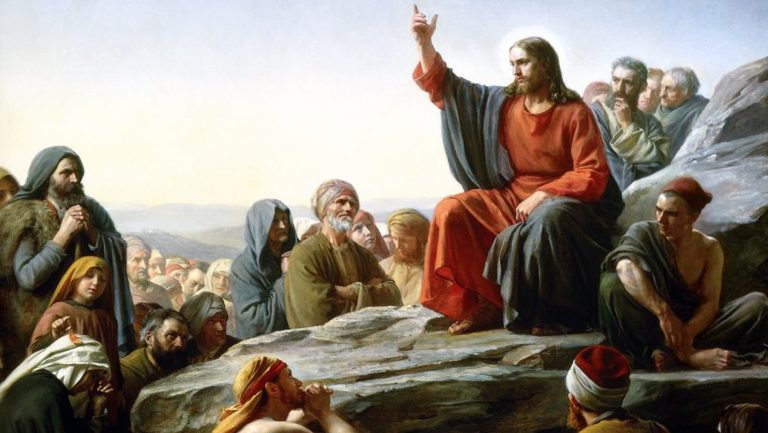By Edward Sri
Dr. Edward Sri is professor of theology and Scripture at the Augustine Institute’s Master’s in Catechetics and Evangelization program in Denver, Colorado. He is the author of numerous books, including God with Us: Encountering Jesus in the Gospel of Matthew.

While the death and Resurrection are the most crucial chapters in the story of Jesus, he did a lot more with his life than offer it up on the Cross. In fact, we won’t fully appreciate the significance of his death on Good Friday until we understand the mission that Jesus had for his life in the years that went before.
What was that mission? First, we know that Jesus became a famous teacher who quickly won the hearts and respect of many Jewish people. We also know that Jesus was renowned for his powerful actions of curing the sick, raising the dead, giving sight to the blind, and expelling evil spirits. With his popularity rapidly skyrocketing, large crowds began to follow him from town to town. Some people gave up everything to become his disciples. Others went so far as to claim him as their king, pinning their hopes on him as the one who would bring Israel’s history to its ultimate destination and its moment of glory.
At the same time, Jesus was also known for being somewhat of a troublemaker. His teachings stirred up great controversy, and he met with fierce opposition from the religious leaders of his day. Many of his public actions were considered out of line with traditional Jewish piety. Even his private social life was under intense scrutiny: in the eyes of some, Jesus was hanging out with all the wrong people—the sinners, lepers, drunkards, and other outcasts with whom most pious Jews would not want to be closely associated.
Moreover, Jesus frequently challenged the ideologies and practices of many Jewish leaders, exposing their hypocrisy and subverting their very authority. He even went after Israel’s most sacred symbol, the Temple, as he stormed into this holiest of buildings and turned the place upside down, flipping over tables and predicting the Temple’s imminent destruction. Actions such as these weren’t the best way to “win friends and influence people” in first-century Judaism. In fact, they brought on many enemies and ultimately cost him his life.
Most of all, Jesus said and did things that the ancient Jews believed only God can do. He calmed the storms and the sea, which was something only the creator could do (Psalms 18:15; 104;7; 107:28–29; Matt 8:26–27). He forgave sins by his own authority, which was something only God could do (Matt 9:1–3). He also taught with his own authority in a shocking way that put himself on par with God. He quoted some of the Ten Commandments given by God on Mount Sinai and then said, “But I say to you,” as he introduced an expansion or deepening of the divine law given to Moses. Think about how alarming that would have been to the ancient Jews hearing this: Who does this Jesus think he is? How can he quote God and then say, “But I say to you”? Who is Jesus to add on to, expand, or deepen what God himself gave us in the Ten Commandments?
Matthew would answer these questions with the unique title he gives to Jesus in the opening chapter of his Gospel. For Matthew, Jesus is not just a leader of a counter-cultural movement. He’s not just a teacher, miracle worker, or prophet sent from God. He’s not just Israel’s savior or redeemer. Jesus is Emmanuel, which means God with us (1:23).
So when we look upon Jesus in Matthew’s Gospel, we must remember we are encountering the face of God. Indeed, the story in Matthew’s Gospel is the story of the God who is with us in his Son, Jesus Christ. At the start of the Gospel, Jesus is introduced as “Emmanuel.” And the kingdom that Jesus is establishing throughout the Gospel of Matthew is all about bringing people back into union with God—not just the faithful Jews of his day but also the sinners, the outcasts, the suffering, and even the gentiles, the non-Jewish people from all the other nations. God will be with his people again through Christ’s kingdom that is breaking down the barriers, going out to the peripheries, calling people to repentance, and reconciling all humanity to the Father.
It’s not surprising, therefore, that we’ll see this theme again at the very close of Matthew’s Gospel. After his death and Resurrection, Jesus commissions the apostles to go make disciples of all nations and he promises, “I am with you always, even to the close of the age” (Matt 28:20). So from beginning to end, the theme of Emmanuel—the theme of God with us—radiates through Matthew’s Gospel in the kingdom Jesus is building.
But if we want to understand how God is with us through Christ’s kingdom, there’s one other title we must grasp: Jesus is the messiah, the king.
Jesus considered himself to be Israel’s long-awaited king—the prophesied “anointed one,” or “messiah”—who would bring God’s plan for Israel to fulfillment and empower Israel to be what it was always meant to be. This mission of building his kingdom was at the center of his teachings and at the heart of all his actions.
You Might Also Like

Much has been said about why Jesus died. This book focuses on why Jesus lived. God with Us: Encountering Jesus in the Gospel of Matthew shows that Jesus didn’t just come to be our teacher, a miracle work or prophet, or even just Israel’s savior and redeemer. Jesus is Emmanuel, God with us. Notable Scripture scholar Edward Sri leads readers on a faithful exploration of Jesus’s kingdom-building mission and how it revealed God presence, which remains with us today.